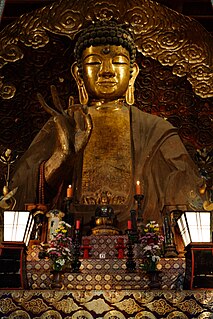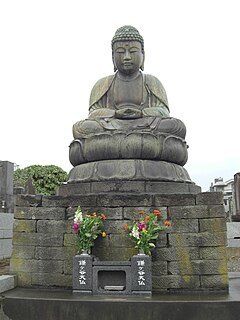 W
WThe Gifu Great Buddha is a large Buddhist statue located in Shōhō-ji in Gifu City, Gifu Prefecture, Japan. It was conceived by the 11th head priest of Kinpouzan Shōhō temple, Ichyuu, around 1790, in hopes of averting large earthquakes and famines. Ichyuu died in 1815 before it was completed, but his successor, Priest Kohshuu completed it in April 1832, after 38 years of construction. It is one of the three great Buddha portrait statues in Japan.
 W
WThe Kamagaya Great Buddha is the smallest Daibutsu in Japan. It is located in the city of Kamagaya, Chiba Prefecture, to the north of Tokyo.
 W
WNōfuku-ji (能福寺) is a Buddhist temple that, from the legend, was founded in 805 by the monk Saichō, in Kita Sakasegawa, Hyōgo-ku, Kobe, Hyōgo Prefecture, Japan. Saichō placed a statue of Yakushi Nyorai of his own making in the temple hall and named the temple Nōfuku Gokoku Mitsu-ji (能福護国密寺).
 W
WŌfuna Kannon Temple is a Buddhist temple in Kamakura, Kanagawa Prefecture, Japan. The statue stands at 25 meters/82 feet tall and weighs nearly 2,000 tons. It depicts the East Asian bodhisattva known as Guanyin or Kannon. Specifically, the Byakue (White-robed) Kannon, one of 33 forms of the Buddhist deity, said to prevent natural disasters, cure the sick, and assist women in childbirth. Ōfuna Kannon Temple (大船観音寺) is a Buddhist temple of the Sōtō school of Zen located in Ōfuna, northern Kamakura. Visitors heading to Kamakura will notice the most prominent feature of the Kannon-ji once their train approaches Ōfuna Station: the 25-metre tall snow-white statue of the bodhisattva Avalokiteśvara, known in Japan as Kannon (観音), the Goddess of Mercy.
 W
WThe Sanuki Sekibutsu (佐貫石仏) is an outline carving of Dainichi Nyorai of unknown origin located in the town of Shioya, Tochigi Prefecture in the northern Kantō region of Japan. It was designated a National Historic Site of Japan in 1926.
 W
WUeno Daibutsu (上野大仏) was an Edo-period giant seated statue of Shaka Nyorai in what is now Ueno Park, Tokyo, Japan. Of bronze and dating to 1631, it was restored after earthquake damage in 1640, a fire in 1841, and again after the 1855 Edo earthquake. Heavily damaged during the 1923 Great Kantō earthquake, when the head was toppled, much of its bulk was melted down for reuse during the Pacific War. In 1972 the face, stored in Kan'ei-ji, was put on display in its former location.
 W
WUshiku Daibutsu (牛久大仏) is a statue located in Ushiku, Ibaraki Prefecture, Japan. Completed in 1993, it stands a total of 120 metres (390 ft) tall, including the 10 m (33 ft) base and 10m lotus platform. The statue held the record for the tallest statue from 1993 to 2008. As of 2018, it is one of the top five tallest statues in the world.